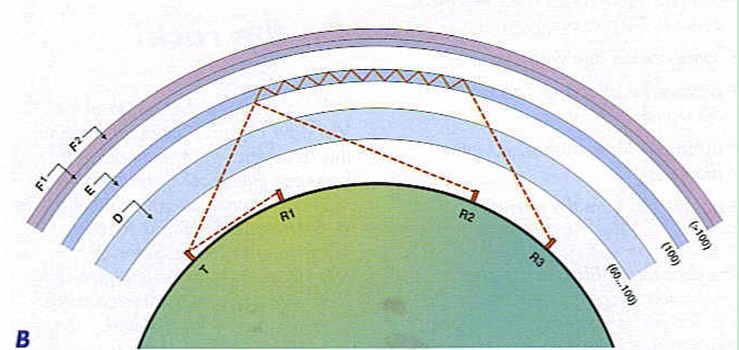

Project Solutions
Propagation - the total surprise factor
Published:2011/7/24 22:36:00 Author:Phyllis From:SeekIC
The propagation of radio waves is a fascinating phenomenon because most of it is guessv/ork and sheer surprise. That is not to say the subject has not been studied extensively by researchers and radio amateurs — far from it, a number of underlying principles have been described in scientific terms as early as the 1920s by Nobel Laureate Sir Edward V. Appleton (1892-1965). Appleton discovered thai radio waves, depending in their frequency, were subject to refraction, reflection and (partial) absorption by certain regions of the earth’s atmosphere. These regions are marked by different electron densities and occur at heights of 60-400 km above the earth. The basic distribution is shown in Figure A. You will search in vain for the A, B and C regions. This is because Appleton first discovered the region around 100 km height and called it ’electron’ region. The D and F (actually Fl & F2) regions were discovered later when the name E region was already established. Today, researchers employ extremely sophisticated radio equipment as well as observations from radio amateurs in an attempt to prove the existence of more ’layers’ in the atmosphere. 
Because it is easily ionised, the E region is favourable for reflection and refraction of signals in the 70 MHz and VHF bands in general. Apart from rather unexpected behaviour, usually during periods of high air pressure, the E region is also predictable in that the electron density drops considerably at sunset due to a lesser degree of ionisation. As an aside, the E region reflects medium-v/ave band signals at night time when the absorption by the D region largely disappears.
Sporadic E (Es) is what we are after for our 70-MHz receiver, and the reason should be obvious if you look at Figure B. Normally, the range of a transmitter T using the VHF-Low band is governed by line of sight, so it will reach receiver R1 as the farthest location. Hov/ever, with a bit of help from Es the signal may be reflected and reach receiver R2 which, seen from T, is way below the horizon. In extreme case the signal may even ’bounce’ within the E layer and reach receiver R3. 
Es is due to the formation of ’clouds’ of densely ionised regions in the atmosphere at a height of 100-125 km. Es typically occurs during summer months, but exceptions have been noted. Given a sufficient degree of ionisation (sometimes helped by sunspot outburst), radio contacts via sporadic E have been made over distances of 2000 miles and more. A good way to check for Es activity is to use your receiver to monitor the signal strength of one of the many beacons in the 70-MHz radio amateur band, or TV stations near the low end of the band. Many years ago, thanks to a peak in sunspot activity coupled with massive Es cloud activity across the Atlantic Ocean, police cars from Boston and New York could be heard loud and clear in Europe, some signals even making it across police repeaters on this side of the ocean. Starski & Hutch Ten-four!
Reprinted Url Of This Article: http://www.seekic.com/blog/project_solutions/2011/07/24/Propagation___the_total_surprise_factor.html
Print this Page | Comments | Reading(459)
Article Categories
New published articles
· Imagination works with TSMC to develop FinFET process
Author:Ecco Reading(33527)
· XMOS pushes event-driven MCUs with lower price
Author:Ecco Reading(3534)
· Intel brings upgraded 32-nm SoC for smartphones
Author:Ecco Reading(3250)
· Micron pushes TLC 128-Gbit NAND flash
Author:Ecco Reading(3816)
· Intel will stop supplying desktop motherboards
Author:Ecco Reading(5341)
· Processor market was expected to regain strength in 2013
Author:Ecco Reading(3318)
· It was reported that TSMC sales fall steeply
Author:Ecco Reading(3474)
· Cisco, NXP work with auto wireless startup
Author:Ecco Reading(3620)
· Micron was impacted by manufacturing glitch
Author:Ecco Reading(4017)
· China can make 22-nm transistor by themselves
Author:Ecco Reading(3820)
· Chip market rebound is coming, according to survey
Author:Ecco Reading(3761)
· Sony, Toshiba will spend more on chips, iSuppli reports
Author:Ecco Reading(3790)
· Qualcomm becomes the 13th company to join NFC Forum board
Author:Ecco Reading(6105)
· TSMC increases building work for FinFET fab
Author:Ecco Reading(3778)
· TI plans to cut 1,700 jobs in OMAP shift
Author:Ecco Reading(4587)